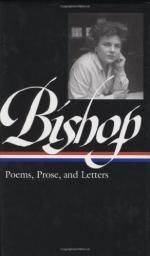|
This section contains 7,702 words (approx. 26 pages at 300 words per page) |

|
SOURCE: Dickie, Margaret. “Elizabeth Bishop: Text and Subtext.” South Atlantic Review 59, no. 4 (November 1994): 1-19.
In the following essay, Dickie examines Bishop's choice of poetic form in relation to her subject matter.
“Elizabeth Bishop is spectacular in being unspectacular,” Marianne Moore claims in her review of North & South (Complete Prose 406) where she notes Bishop's “mechanics of presentation,” not just the rhymes, but the accuracy and modesty of the poetry. Yet Bishop could also be spectacular in being spectacular, relinquishing her art's modesty to elaborate, even archaic form, in poems, strangely enough, of current social and political concern. It may not be an entirely unknown combination for a poet (one thinks of Auden, for example); but, for Bishop, who did indeed perfect the minimalist style for which Moore praises her, it is especially puzzling.1 Still she did write a sestina on the Depression, a double sonnet on alcoholism, a poem...
|
This section contains 7,702 words (approx. 26 pages at 300 words per page) |

|


